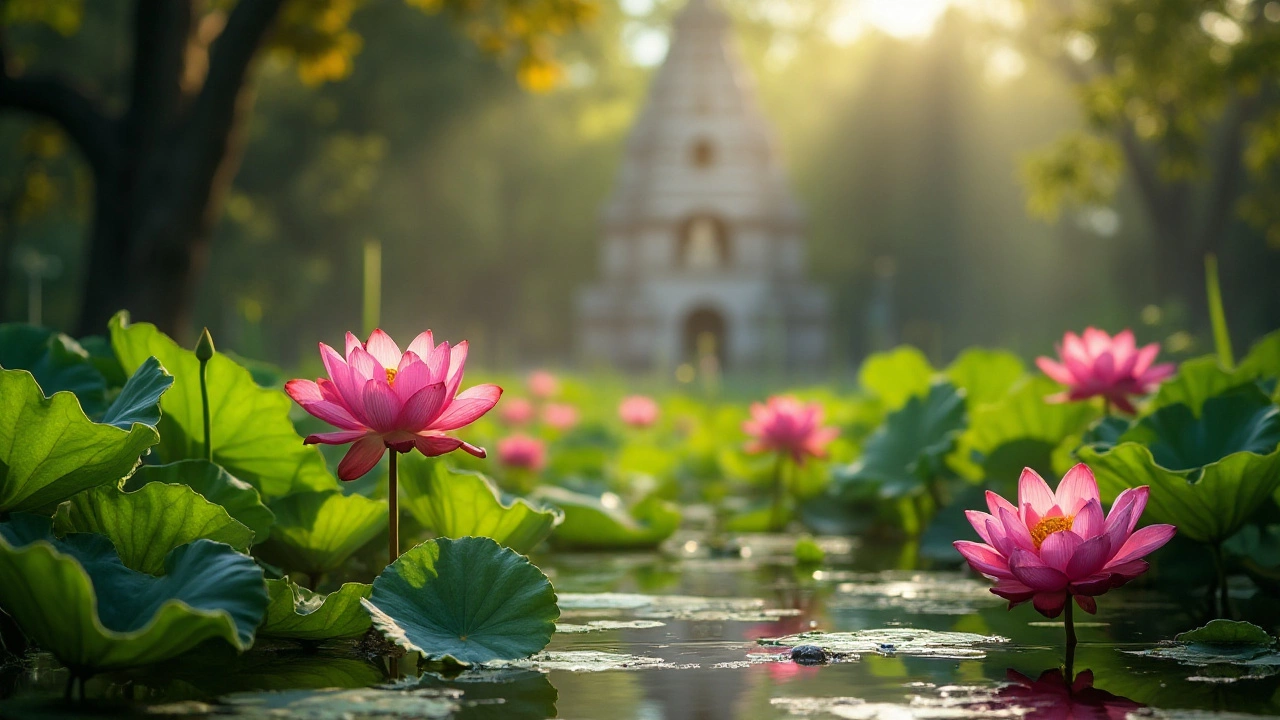The allure of the sacred lotus, known scientifically as Nelumbo nucifera, stretches far beyond its striking appearance. In India, the lotus holds a revered status that goes hand in hand with its cultural and spiritual roots. This flower is not just a sight for sore eyes; it's a profound emblem of purity and enlightenment.
From ancient myths to modern gardens, the lotus has been cherished as a bearer of deep meanings and associations. Its ability to rise untainted from the muddy waters has made it a powerful symbol across Hinduism and Buddhism, representing spiritual insight and rebirth. Yet, beyond the spiritual realm, its delicate beauty invites gardeners to explore its cultivation in their own spaces.
In this guide, we'll dive into the fascinating world of India's sacred flower, unraveling its rich heritage, and offering practical tips for those who wish to introduce this timeless bloom into their garden oasis.
- The Lotus in Indian Culture
- Symbolism and Spiritual Significance
- Botanical Characteristics
- Cultivating Lotus in Your Garden
- Lotus in Art and Mythology
The Lotus in Indian Culture
The sacred lotus has woven itself into the rich tapestry of Indian culture over millennia, representing much more than just a perennial aquatic plant. Its significance goes beyond its visual grace to embody themes of creation, purity, and spiritual awakening. The plant's journey from murky waters to the brilliant surface echoes with the essence of transcendence, making it a prominent symbol in Hindu philosophy.
One cannot overstate the deep spiritual resonance the lotus has within Hinduism. The god Brahma, often visualized seated on a lotus, draws symbolic connections to the flower's creative purity. In sacred texts such as the Rigveda, the lotus is spoken of in relation to the birth of the universe, underscoring its esteemed place in the lore. Often referred to as 'Padma' or 'Kamal' in Sanskrit, it acts as a metaphor for detachment, with water droplets slipping off its petals as if untouched, representing how one can live in this world yet remain untainted by its trials.
Not only does the sacred lotus hold sway in Hindu beliefs, but Buddhism too has embraced its symbolic power. In Buddhist teachings, the flower signifies the potential for all beings to develop from the lowest state of existence to the state of enlightenment. Early Buddhist art often carved lotuses at the feet of Buddha statues, enhancing this icon with its emblematic power. According to a popular saying attributed to Lao Tzu, "The lotus grows in mud, yet it blooms in the sun, unsoiled by impurities." This encapsulates the belief that individuals too can rise above their struggles to achieve purity and enlightenment.
The art and architecture of India, spanning from ancient times to the present, are replete with representations of the lotus. Temples dedicated to various deities feature motifs of the flower in stone carvings, frescoes, and sculptures, highlighting its revered stature. Perhaps the most magnificent modern homage is the Lotus Temple in Delhi, an architectural wonder reflecting the beauty and symmetry of the flower itself, drawing visitors and seekers from around the globe to witness its serene splendor.
Considering the lotus's cultural ubiquity, it is not surprising that it finds itself frequently featured in India's festivals and rituals. During ceremonies, garlands made from lotuses are often used to honor deities and dignitaries, and the petals are employed in various traditional dishes and medicinal concoctions, showcasing its versatility. In culinary practices, the lotus seed, known as 'makhana', is often included in various Indian sweets and snacks, valued not just for its taste but also its symbolic overtones.
It is in the poetry and literature of the Indian subcontinent where one finds some of the most evocative uses of the lotus as a metaphor. Poets write about the beauty of the lotus to describe their muses, likening the elegance of its bloom to the beloved's eyes or grace. Tagore, the Nobel laureate, penned lines comparing his homeland's fields to a rushing river, with lotuses growing alongside, capturing the tranquil but purposeful beauty of Indian landscapes. Through painting such visions in words, the lotus continues to embed itself as an enduring image in the cultural narrative, standing as a reminder of resilience, grace, and purity amid adversity.
Symbolism and Spiritual Significance
The sacred lotus holds a revered place in the spiritual and cultural tapestry of India, serving as a poignant emblem of purity and divine beauty amidst earthly pollution. It is celebrated in Hinduism and Buddhism, where it symbolizes the journey of the soul towards enlightenment and transcending the human condition. This flower’s enchanting ability to remain unstained by the muddy waters it grows in is seen as an allegory for maintaining detachment from worldly desires and impurities, embodying the pursuit of spiritual truth and harmony.
In Hindu mythology, the sacred lotus is often associated with deities. For instance, the goddess Lakshmi is frequently depicted as standing or sitting on a fully blossomed lotus flower, denoting divine beauty, prosperity, and fertility. Similar depictions of Lord Vishnu demonstrate the lotus's powerful presence in the paradisiacal depictions of creation. Additionally, historical texts mention the lotus as the birthplace of Brahma, the creator god, further underscoring its spiritual significance as a symbol of creation and cosmic balance.
Buddhist teachings also revere the lotus, highlighting its journey from muddy waters as a metaphor for purity achieved through suffering and perseverance. The blooming of the flower is synonymous with the blooming of the human spirit—an aspirant working through life's challenges to attain enlightenment. “Just like a lotus flower we too have the ability to rise from the mud, bloom out of the darkness and radiate into the world,” Buddha's teachings often emphasize. Here, the lotus assumes a dual role, embodying both the struggle of life and the profound serenity that enlightenment brings.
The cultural impact of the sacred lotus extends to art and literature as well, where it frequently appears in poetry and paintings as a motif of aesthetic brilliance and spiritual depth. The lotus's universal acceptance across different epochs in Indian art—as seen in ancient cave paintings and modern renditions—further cements its role as a timeless symbol. Its seeds, known for their longevity, bring another layer of symbolic meaning, reflecting concepts of immortality and regeneration, offering an assurance of renewal beyond physical death. A table below illustrates the correlation between different religions and the symbolic meanings attributed to the lotus:
| Religion | Symbolic Meaning of Lotus |
|---|---|
| Hinduism | Purity, Fertility, Spiritual Awakening |
| Buddhism | Enlightenment, Detachment, Perseverance |
Thus, the lotus serves a dual purpose in Indian culture, functioning as a constant reminder of achieving spiritual awakening while demonstrating beauty and life’s ephemeral nature. Whether depicted in scripture, portrayed in paintings, or cultivated in gardens, its magnificent bloom continues to inspire reverence and reflection and invites individuals to see beyond mere appearances, searching for deeper truths.

Botanical Characteristics
The sacred lotus, Nelumbo nucifera, is truly a wonder of nature. Native to the water bodies of India, this aquatic plant is known for its resilience and unrivaled beauty. The lotus family is quite distinct, not to be confused with the water lily despite their superficial similarities. The sacred lotus is a master of adaptation, thriving in the murky waters devoid of any lifeline from the land. This fascinating plant stands tall, with its leaves rising above the water surface like miniature umbrellas. Each leaf, broad and round, can reach up to three feet in diameter, providing a platform for the exquisite flowers that emerge.
These flowers, a symphony of pink and white petals, can measure up to a foot across. Their petals unfold majestically, revealing a sunburst of yellow stamens at their heart. It is a bloom that can endure for more than three days, opening with the first light of dawn and often closing as night falls, creating a rhythmic dance with the natural cycle. One of the intriguing aspects of the lotus is its thermoregulatory capability. Yes, you read that right—unlike most plants, the lotus can maintain its internal temperature, almost like warm-blooded animals. This unique feature hasn't just puzzled botanists but has also cemented its status as a symbol of life in its most dynamic form.
Underneath this beauty lies an intricate root system deeply embedded in the soft substrate of its watery habitat. The rhizomes of the sacred lotus not only secure the plant but also serve as a food source rich in nutrients such as carbohydrates and minerals. This root structure allows the lotus to be an excellent oxygenator, contributing positively to the ecosystem of its aquatic environment. As is often recounted in botanical literature, "the lotus is not just a plant; it is a marvel of nature's engineering" (
Botanica Magnifica), displaying an elegant blend of strength and grace in its design.
For those interested in gardening, the sacred lotus presents a rewarding challenge, requiring specific conditions to flourish outside its natural habitat. The key is replicating its preferred environment, which involves a constant supply of still or slow-moving water and warm temperatures that emulate its native lands. When cultivated, the sacred lotus can transform gardens into tranquil sanctuaries, attracting diverse species of wildlife while enhancing the natural beauty and serenity of the space. This symbiosis between the plant and its surroundings is just one more reason why the lotus holds such a revered position in both the natural world and the hearts of those who tend to it.
Cultivating Lotus in Your Garden
For those enchanted by the mystical aura of the sacred lotus and wish to invite its serene elegance into their garden, cultivating this revered bloom can be a manageable yet rewarding endeavor. The journey of growing lotus begins with understanding its natural habitat — calm, shallow waters with full sunlight exposure, mirroring the placid ponds and lakes of its native landscape. Lotus thrives in tropical to subtropical climates, with its seeds boasting an astonishing ability to remain viable for hundreds of years if preserved properly, a testament to its resilience and deep-rooted symbolism of rebirth and perseverance.
Before initiating your cultivation journey, consider the environmental needs of the lotus plant. An essential first step involves choosing the right container or pond. Traditional gardeners often use wide, shallow pots fitted with no drainage holes. This ensures the water stays intact, providing the wet conditions crucial for lotus growth. Position the pot or pond in a spot where it will receive at least six to eight hours of direct sunlight each day. The combination of sunlight and water is pivotal; without it, the growth could be stunted, rendering this radiant bloom just a shadow of its potential.
Now, let's delve into the key steps of planting the lotus. Begin by acquiring tubers from a reputable source, ensuring they are healthy and disease-free. Once you have your tubers, gently place them in a pot filled with clay soil, taking care to leave the growth tips above the soil surface. Submerge the pot gradually into the water, taking care not to disturb the tuber. As the plant develops, leaves will emerge above the water, eventually giving way to the striking blooms that are a hallmark of this ancient plant.
"The lotus evolves under the most serene circumstances, reflecting tranquility and spiritual growth, which resonates with gardeners worldwide as they nurture its journey," shared an expert from Botanical Gardens.
Ongoing care is essential for your lotus to prosper. Regularly check the water level, ensuring it remains above the pot line, and watch for signs of pests such as aphids that might detract from its natural beauty. Seasonal pruning, particularly of spent flowers and yellowing leaves, will promote robust growth and sustained flowering. Remember, patience is key — lotuses are slow to establish, but once settled, they reward you with years of stunning, spiritual blooms.
To visualize the basic care requirements of the sacred lotus, see the outline below:
| Requirement | Details |
|---|---|
| Sunlight | 6-8 hours daily |
| Water Temperature | 21-28°C (70-80°F) |
| Soil Type | High clay content, no sand |
| Container | No drainage holes, shallow wide pots |
By emulating the serene, watery environments emblematic of its native habitats, you stand poised to cultivate an impressive spectacle of lotus blooms. As you nurture this remarkable plant, not only do you grow a garden, but you also cultivate a living symbol of purity, wisdom, and beauty, right at home.

Lotus in Art and Mythology
The sacred lotus finds a cherished place in the canvases of art as well as the sands of mythology across India. Its presence is not merely ornamental but deeply entrenched in the spiritual and philosophical narratives that have been passed down through millennia. The lotus often symbolizes the idea of life, growth, and spiritual awakening in cultural tales. Artists and storytellers have been drawn to its image, drawn by both its physical beauty and symbolic power. This elegant flower emerges from the muck yet remains untouched, much like the human spirit rising above trials to find clarity. It is a story woven with lines of hope and resilience, reminiscent of the way a lotus stands tall amidst adversity.
In Hindu mythology, the lotus is said to give birth to the universe, floating effortlessly on the cosmic oceans until it gives rise to creation. This divine connection makes it a much-loved motif in paintings and sculptures. For instance, Lord Brahma, the Hindu creator god, is depicted seated upon a lotus, illustrating its central place in the cosmology of creation. Similarly, Goddess Lakshmi, symbolizing wealth and purity, is often presented sitting or standing on a blooming lotus, hinting at all things auspicious thriving with abundance and purity.
Buddhist art also reveres the lotus, seeing it as a symbol of enlightenment. The flower's journey from murky waters to radiant bloom mirrors the path to spiritual purity and wisdom. It is believed that Lord Buddha was born with the ability to walk immediately after birth, and lotus flowers are said to have sprung up in his footprints, leading him into the world. This imagery further entrenches the flower as a guide to spiritual discovery.
"Unlike the drop of water which loses its identity when it joins the ocean, man does not lose his being in the society in which he lives. Man's life is independent. He is born not for the development of the society alone, but for the development of his self too." - B. R. Ambedkar
In artworks, the lotus is lavishly depicted in various styles, acting as a meditative point of focus. Murals, frescoes, and even poetry celebrate this flower's symbolism across the Indian subcontinent. Through temple carvings and ancient texts, its narrative spills beyond local tales into global consciousness, maintaining relevance in modern interpretations. There’s an artistry in the way it links natural beauty to metaphoric value, compelling artists to keep reimagining its form.
The connection to the Indian flowers extends to how the lotus is encapsulated in rituals and sacred architecture. Its geometric symmetry and vibrant hue serve as models of perfection and divine beauty, ensuring its image is apotheosized in altars and temples. These enduring representations are a testament to the flower's impact, unfading like its name, and as inspiring as the stories it births. For gardeners planting the sacred lotus, they are partaking in a tradition that transcends mere cultivation, connecting to a deeper aesthetic truth that raises the ordinary into the sublime.





